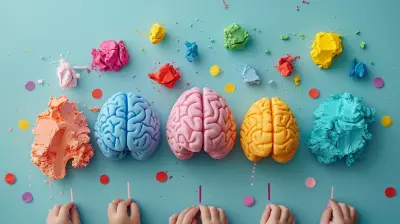Cognitive Flexibility: Why It Matters for Kids’ Development
11 October 2025
Think back to when you were a kid. Remember playing a game, and suddenly the rules changed mid-way? At first, it was probably frustrating, right? But then you figured it out, adjusted, and maybe even giggled at the new challenge. That little moment is a perfect peek into cognitive flexibility at work — a crucial skill kids need as much as they need to tie their shoes or say their ABCs.
So, what is cognitive flexibility, and why should we care so much about it? Let’s break it down in simple terms and see how this mental muscle shapes the lives and development of children.
What is Cognitive Flexibility?
Cognitive flexibility is basically a fancy way of saying "mental adaptability." It's our brain’s ability to switch gears, think about things in different ways, or shift from one task or rule to another without getting stuck.For kids, this could mean:
- Moving from math class to art without carrying over frustration.
- Figuring out a new way to solve a puzzle when the first one doesn’t work.
- Adjusting behavior when they realize their friend is in a bad mood and doesn’t want to play.
It's one key part of what's called "executive functioning" – the behind-the-scenes brain work that helps us plan, focus, remember instructions, and juggle tasks.
Why Is Cognitive Flexibility So Important for Kids?
Here’s the deal — life’s messy and unpredictable. Kids face a ton of changes every day. Whether it's a new teacher, unexpected homework, or changing social dynamics on the playground, they need a brain that can pivot smoothly.Let’s dive into a few specific ways cognitive flexibility sets the stage for success:
1. Better Problem-Solving Skills
Kids with high cognitive flexibility can think in more than one way. If Plan A falls through, they don't shut down—they try Plan B, Plan C, or even make up Plan D on the spot.Ever seen a child try to assemble LEGO with missing pieces and still create something epic? That’s flexibility in action. They're not just building with plastic bricks—they're learning how to work around problems.
2. Stronger Social Skills
Let’s be honest—socializing is a minefield, especially for little ones. It takes flexibility to read social cues and respond with kindness and awareness. One moment you’re joking around, the next you're apologizing because someone didn’t find it funny. It happens.Kids who can shift perspectives and adapt to others’ emotions tend to build deeper friendships and resolve conflicts more easily.
3. Greater Academic Success
Schools aren’t just about memorizing facts. They require kids to jump between subjects, follow multi-step instructions, and adjust when the routine changes.Flexible thinkers can switch between tasks without losing focus or feeling overwhelmed. This means they tend to handle transitions better and are more open to learning from mistakes—a win-win in any classroom.
4. Improved Emotional Regulation
Let’s face it, kids aren’t always the masters of calm. Tantrums, meltdowns, and emotional outbursts come with the territory. But here’s where cognitive flexibility shines—it helps kids take a breath, reframe situations, and find better coping strategies.Think of it like this: flexibility gives them a mental “pause” button. Instead of reacting impulsively, they can assess and adjust.
What Happens When Cognitive Flexibility is Lacking?
When kids struggle with mental flexibility, you might notice things like:- Difficulty adjusting to new routines
- Meltdowns when plans change
- Trouble solving problems creatively
- Rigid thinking (everything has to be done one specific way)
This doesn’t mean a child is doomed or broken—it simply means they're wired differently or need more skill-building in this area. And guess what? Like muscles, cognitive flexibility can be strengthened with practice.
How Can Parents and Teachers Nurture Cognitive Flexibility?
Okay, so we know cognitive flexibility matters. But how do we actually help kids grow it?Spoiler alert: It doesn’t require fancy tools or expensive programs. Often, it’s about shifting how we approach everyday moments.
Here are some tried-and-true strategies:
1. Play Games That Require Switching
Board games and card games are more than just fun. Games like Uno, Simon Says, or even classic memory games encourage kids to follow shifting rules, remember patterns, and adapt in real-time—all without them realizing they’re doing brainwork.Even video games that involve strategy and decision-making can support this kind of thinking (in moderation, of course).
2. Encourage Open-Ended Questions
Instead of asking, "What's the answer?" try asking, "What are some different ways we could solve this?" or "Can you think of another way to look at it?"Open-ended questions prompt kids to flex their mental muscles and think beyond black-and-white answers.
3. Model Flexibility Yourself
Let’s be real—kids are watching us like hawks. If we stress out when plans change or get stuck in our own ruts, they’ll pick up on it.So, when the unexpected happens (because it always does), use it as a teachable moment:
“Oh! Our picnic got rained out. That’s a bummer, huh? How about we build a fort inside and have an indoor snack party instead?”
Boom. That’s real-life cognitive flexibility in action.
4. Normalize Mistakes and Encourage “Plan B”
When kids mess up (and they will), resist the urge to jump in and fix everything. Instead, guide them to brainstorm alternatives.“You spilled the glue—now what do you think we can do to fix it?”
It’s not about being perfect. It’s about learning to pivot, adjust, and keep moving.
5. Mix Up the Routine (Gently)
Children thrive on routine, but too much rigidity can limit flexibility. Try adding small, manageable changes to their routines. Maybe a different route to school or a new bedtime story genre.These tiny shifts teach kids that change isn’t scary—it can even be fun.
Cognitive Flexibility and Neurodiversity
It’s important to note that cognitive flexibility can look different across the spectrum of neurodevelopment.Children with ADHD, Autism Spectrum Disorder (ASD), or certain learning differences might find flexibility more challenging. And that’s okay. Their brains process the world uniquely, and they may need extra scaffolding and support.
We’re not aiming for perfection. We’re aiming for growth—at their pace, in their way.
That might mean:
- Using visual schedules to ease transitions
- Offering more time during task switchovers
- Practicing social stories or role-plays to prepare for changes
The key? Patience, empathy, and support.
How Schools Can Support Cognitive Flexibility
Teachers, this one’s for you. Classrooms are pressure cookers of cognitive demands. But the good news? They’re also ideal environments to nurture flexible thinking.Here’s how:
1. Flexible Seating and Learning Choices
Let students choose where or how they work sometimes. Giving options (“You can work standing, sitting, or lying on your stomach”) sparks brain engagement and ownership.2. Promote Mistake-Friendly Culture
When mistakes are embraced as part of the learning journey, kids feel safe to try new approaches. Use language like, “Great try—what else could we do here?”3. Use Cross-Curricular Activities
Connect science to art, math to music. When kids see how ideas overlap, they’re training their brains to make connections and shift between contexts more naturally.Long-Term Benefits: Why It Really Pays Off
Let’s fast forward a bit. You’ve got a kid who’s practiced cognitive flexibility throughout childhood. What kind of teen or adult do they become?Here’s a snapshot:
- They face change with calm curiosity (instead of panic).
- They handle stress better—at home, at school, and in the workplace.
- They’re innovative, resilient, and open-minded.
- They’re empathetic and adaptable in social situations.
In short, they’re prepared for real life. And in an ever-changing world, that’s pure gold.
Final Thoughts
Cognitive flexibility isn’t just a “nice-to-have” skill—it’s a foundational piece of the developmental puzzle. When kids learn how to adapt, shift, and think in new ways, they’re better equipped to handle the curveballs life throws their way.You don’t need a PhD or a therapist’s toolkit to support it. Just a bit of awareness, a playful mindset, and a willingness to ride the unexpected waves alongside your child.
Because when we guide kids to be mentally flexible, we’re not only teaching them how to think—we’re teaching them how to thrive.
all images in this post were generated using AI tools
Category:
Cognitive DevelopmentAuthor:

Jenna Richardson
Discussion
rate this article
1 comments
Delilah McMichael
Imagine a world where kids can pivot like gymnasts! Cognitive flexibility isn’t just a buzzword; it’s the secret ingredient to their developmental smoothie—mixing creativity, resilience, and adaptability!" 🍹🧠
October 12, 2025 at 3:46 PM

Jenna Richardson
Absolutely! Cognitive flexibility empowers kids to navigate challenges with creativity and resilience, making it essential for their growth and development. 🌟


